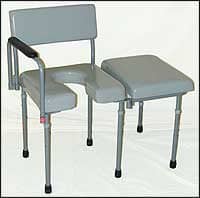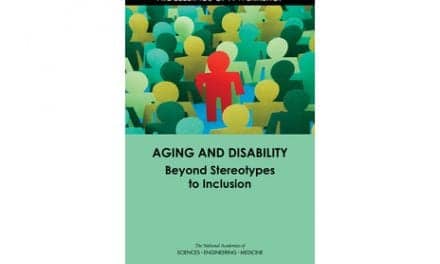by Kathleen Kirchner, MA, OTR/L, and Carol Wasserman, MPT
For therapists thinking of working in the area of home modification (HM), there are reasons for excitement: a rising demographic of persons wanting to “age in place,” a burgeoning public health interest in falls prevention, and the personal and professional satisfaction that comes with helping clients to solve complex problems. These therapists apply traditional, professional skills in innovative ways to benefit the community. However, there is a myriad of challenges in establishing acceptance for the rehabilitation perspective on a building team, as well as building consumer awareness about the benefits of the rehabilitation point of view.
Home modification is a new phase in the aging and disability rights movements. Sparked by the Civil Rights Movement of the 1950s and 1960s, the Independent Living Movement of the 1970s and 1980s advocated rights for people with disability. The movement’s multiple coalition efforts led to the passage on July 26, 1990, of the Americans with Disabilities Act (ADA), requiring accommodations for people with disabilities to access public spaces and commercial buildings.
Those accessibility features were designated as Universal Design (UD) because they are designed for the use by most people, most of the time, regardless of the person’s size or ability level. That is, for inclusive design at a minimum level of accessibility as defined by wheelchair use. Most Americans are familiar with, and indeed regularly take advantage of, the now widely present UD features such as curb cuts, automatic door openers, and lever door and faucet handles.
Currently, Baby Boomers are driving an awareness of active aging lifestyles, which includes choices of moving to retirement communities or making UD modifications to their homes as they plan to age in place. Parents pushing youngsters in double jogger strollers, visitors in wheelchairs, and residents using crutches postoperatively all appreciate the benefits of UD.
Individualized Design
The next phase of home modification evolution is Individualized Design (ID). With ID, we recognize that one size does not fit all. This is often the case when someone has had a traumatic injury, has multiple disabilities, or has a progressive neurological condition. These people already have specific mobility, sensory, or cognitive deficits—or a combination thereof—and these deficits usually have typical future sequelae. These people often need individualized HM unique to their current and projected future needs, not universal and not “cookbook” prescriptions.
Key in determining an optimal individualized HM plan is assessing how the person functions in the home, how he performs his activities of daily living, and how he performs his instrumental activities of daily living—not just checking an activities list. We believe that anyone making specific modification recommendations for people with disabilities or progressive disease should understand the client’s multi-system disease, medical condition, and physiological aging process—and where the client currently is on the continuum—in order to address both current and future safety and functional needs.
Home Modification Technologies
Multiple technologies are available for ID in making a HM plan for remaining at home and living as independently as possible. There is special auditory technology for people with low vision, special visual technology for people with low hearing, safety technology for people with dementia, and automated features in kitchen and bath appliances and fixtures. There are several assistive mobility accommodations which are especially important for individuals with spinal cord injury, brain injury, or degenerative conditions such as multiple sclerosis (MS) or Parkinson’s disease.
For example, in homes with multiple floors, a stairlift (or stair glide) can provide easy access between floors. This is a good option for someone recently discharged from a rehabilitation center after having a stroke or for someone with early lower extremity symptoms of MS. Likewise, for an elderly individual who is still ambulatory, but has poor balance or lower extremity weakness, a stairlift may provide a much safer way to negotiate stairs. However, a stairlift is not always the solution. For instance, someone who uses a wheelchair and has very poor trunk control, such as someone with quadriplegia or severe ataxia, may need an inclined platform lift to negotiate stairs safely at home.
House entrances often present an obstacle to mobility, due both to stairs and to raised thresholds. Some of the above-mentioned stair accommodations are available for outdoor use, as are vertical platform lifts. Ramps are popular accommodations at home entrances. Concrete ramps, as well as ground elevation change via landscaping, are permanent choices for people who own their homes. Portable ramps may be the solution for rental homes, visitor accessibility, or for short-term use. There is a variety of modular aluminum and wood ramps available as pre-engineered kits. These ramps are designed to provide access for distances as short as from a van to a sidewalk, from sidewalk to threshold, over a variety of thresholds, or across a lawn and up to a door.
Movement into and throughout the home can be assisted by automated door-opening systems. Such systems are available in configurations that can be operated by motion detection, remote control mounted to a mobility device, or by push pads mounted to walls. There are several ceiling and mobile lift devices which also assist with mobility within the home, their primary benefit being caregiver safety during transfers of dependent individuals. Some ceiling lifts are designed simply to aid in the transfers between a bed and a wheelchair, while others also move an individual between rooms via a motorized trolley that moves along an overhead track. A non-motorized mobile lift may be a more affordable solution for toilet, wheelchair, and bed transfers and for moving a dependent person between rooms.
Rehabilitation HM professionals are liaisons between clients’ healthcare providers who manage the person and architects, contractors, designers, and durable medical equipment vendors who manage the house. This is the essential niche for rehabilitation professionals in HM—and is “value-added” to the design-build team.
Optimal Role for Home Modification Consultants
Similar to a multidisciplinary team in the clinical setting, the HM team is very important for people with special needs who desire home accessibility improvements. There is a role for everyone on the team, including the client, family, and caregivers. Most people would not expect the rehabilitation HM consultants to know how to design integrated rooflines, move weight-bearing walls, install doorways with flush thresholds, install elevators, or to design custom lighting and built-in features. Likewise, we do not expect building professionals to understand human pathophysiology, task analysis of activities of daily living, compensation strategies for neurological impairment, or caregiver demand and safety. We are encouraged to see the evolution of building professionals seeking advice from health care providers for help in determining the client’s functional needs prior to the start of the home modification.
Our role as rehabilitation HM consultants is work-intensive at the project’s onset. The optimal team role we see evolving begins with our safety assessment of the client within the home. We consult with the client, family, caregivers, and clinical healthcare providers, then provide a written report. In the report we identify options at various price points and specific product specifications (such as “wide-handled single-lever side-mounted faucet”). Then the architect, designer, contractor, equipment vendor, and client use our recommendations in determining the final home modification plan. The contractor and durable medical equipment vendor make the modifications. The interior designer, decorator, or client selects specific fixture and appliance brands and models which meet our functional specifications. Periodically, we monitor to assist with placement, compliance, inevitable issue resolution, and consumer education.
There remains resistance to rehabilitation input in designing ID. Clients are sometimes still in denial about their diagnoses, lack understanding of their safety risks, and have difficulty projecting their future needs. Frequently, clients and family members fear the cost of another professional’s input and that the modifications will result in an institutionalized appearance. The building team may consider that adding the therapy perspective complicates the process, adds to the cost of the job, decreases communication with the client, and results in a loss of their control.
There are several important benefits to the therapy perspective of individualized HM. For the client, it provides for the unique optimal safe functional performance at the start and accommodates to change in the expected future functional status. An ethical HM consultant with a rehabilitation background should be able to identify equipment and room layout for effective functional assistance at various price points. The client can be confident that the recommendations are made in the client’s best interest, not that there is any financial incentive on the consultant’s part.
Confidence in decisions affecting prolonged safety and independence in the home provide an excellent long-term cost benefit for the client. Appropriate individualized design also benefits the design team by getting the remodel right the first time. Putting the person’s needs first enhances the credibility and reputation of each of the HM team members.
From the rehabilitation perspective, there are numerous benefits of working with a trusted, knowledgeable durable medical equipment vendor. The rehabilitation home modification consultant relies on the vendor to know his equipment: the specific capabilities, extra options, limitations, proper installation, cost, warranties, and completed installation date of the various models he sells. Before equipment ordering, the competent vendor needs to identify environmental factors which would prevent proper installation or use of their equipment, such as inadequate wall space to extend a stair glide far enough beyond the top stair to allow for safe transfers. Vendors who understand the importance of, and consistently follow through with, providing reliable, timely, and cost-effective repairs on equipment they installed are invaluable to the client and family. This type of vendor is a rehabilitation HM consultant’s dream.
The smoothness of the remodel process is highly dependent on the selected building contractor. A rehabilitation HM consultant revels in working with a contractor who is comfortable with clients having various abilities, who knows the local building codes, who remains open to advice from the rehabilitation HM consultant, and who enjoys the challenge of problem-solving. For effective ID, the building contractor does not necessarily need to have special HM training or designation, but he does need an excellent work ethic and to be a good team player. A good example of rehabilitation professional and building professional teamwork is Safe at Home. Through a federal grant, this program of the District of Columbia Office on Aging has successfully paired occupational therapists and construction contractors in providing individualized HM for low-income elderly and disabled residents.
We have learned that most HM cases where the client has a significant traumatic injury, some developmental conditions, or progressive neurological conditions need individualized design and that a rehabilitation perspective is indicated in determining the optimal design. We have learned that it is imperative that all remodel team members must work together, communicating when they question a component of the remodel before mistakes are made or independent decisions veering from the plan are made. In one case, a family requested evaluation for a stair glide for a client with dementia. The rehabilitation HM consultant’s assessment revealed that the client was unable to transfer safely onto the stair glide and became too anxious to tolerate transport over the stairway. In this case, the consultant and contractor worked out a plan which incorporated a vertical platform lift—a more economical, functional choice.
Seeing the Big Picture is a Key Advantage
The rehabilitation HM consultant’s most valuable contribution is the ability to anticipate the client’s long-term needs. In another case, the ID bathroom plan was designed for a very tall client recently diagnosed with Amyotrophic Lateral Sclerosis (ALS). The rehabilitation HM consultant recommended a number of products for commode and sink access that would be functional throughout the client’s disease process. These decisions were overridden by the interior designer managing the case who chose high-end UD products, rather than those selected for the client’s specific needs. In this case, a HM team member’s independent decisions resulted in significant monetary and functional cost for the client. The costs may not have been apparent to the client at the completion of the construction, but were readily evident through the progression of the client’s disease.
As a result of inexperience, lack of knowledge, or no ID plan, we have seen numerous improperly installed ramps and door systems. Those improper choices and installations incur a greater cost than if they had been planned and executed correctly at the outset. These costs of correcting improper design or installation usually far exceed the cost of the rehabilitation HM consultant’s fee.
Through continuing education, the rehabilitation HM consultant can add value to the HM team. Currently, popular certifications are the Certified Aging in Place Specialist (CAPS), Certified Environmental Access Consultant (CEAC), and Executive Certificate in Home Modification (ECHM). The National Association of Homebuilders (NAHB), partnered with AARP (formerly known as the American Association of Retired Persons), has done an outstanding job of promoting UD in allowing people to stay in their home longer through their three day Certified Aging in Place Specialist (CAPS) Course. This designation is widely used among design and construction professionals to convey HM expertise.
Accessible Home Improvement of America (AHIA) administers the Certified Environmental Access Consultant (CEAC) certification of professionals working in the environmental access and accessible home modifications industry. The CEAC seeks to provide some consistency among professionals working in the field through education, testing, certification, and networking.
In 2004, The University of Southern California (USC) Andrus Gerontology Center started providing another evolutionary step in HM education. While NAHB provides the HM overview and awareness course, USC provides the comprehensive HM course. Building, healthcare, and aging services professionals desiring in-depth HM training can take USC’s 5-month interactive online Executive Certificate in Home Modification (ECHM) Course. This course emphasizes Individualized Design, HM team approach, and community HM coalition initiatives.
We have a three-fold goal for people with disability or progressive disease who desire HM. That is, there is consumer-driven insistence that home modifications must be individualized, all individualized HM plans are based on a comprehensive assessment by an appropriately trained rehabilitation HM professional, and that the HM team works cooperatively for the client’s best interest. RM
Kathleen A. Kirchner, MA, OTR/L, works in community-based settings through the Johns Hopkins University School of Nursing/Center for Innovative Care in Aging and the District of Columbia’s Office on Aging Safe at Home program.
Carol Wasserman, MPT, is a retired United States Army Physical Therapist (PT). For 20 years she treated a diverse range of patients of all ages, from inpatients affected by serious illness to acute outpatients, specializing in neurologic physical therapy, multiple trauma, and neonatal intervention.
Kirchner and Wasserman are co-owners of Accessible Home Associates LLC, a home modification consulting business serving the Metro DC area. They each hold the Executive Certificate in Home Modification and Certified Aging in Place credentials. For more information, contact [email protected].





